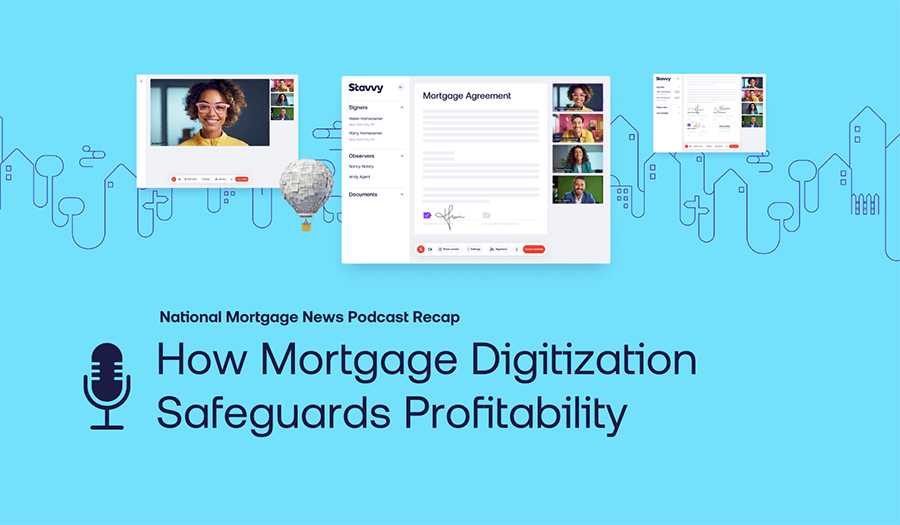The mortgage industry and mortgage servicing policy are always in flux.
In today’s environment, delinquencies and foreclosures are relatively low. Homeowners tend to be equity-rich. HELOC volumes picked up over 2022/2023, and that trend is expected to continue, although at a different pace. At the same time, credit card debt is rising, adding complexity to housing affordability for homeowners.
The interconnectedness of these economic factors necessitates that mortgage servicing policy react to the environment at hand. When the environment is trending in a positive direction like it is today, the industry has the opportunity to be proactive and improve the toolkit it has to work with.
Stavvy recently sponsored The Five Star Institute Webinar Series with an exploration of the topic, “Preparing Mortgage Servicing for Policy Flux.” Panelists discussed the current environment, anticipated policy shifts, and how technology can help navigate the complexities of these changes. Stavvy’s Chief Strategy Officer, Angel Hernandez, was joined by the following panelists:
- Lisa Banal - Assistant General Counsel, JPMorgan Chase
- Ryan McGuinness - Mortgage Servicing Policy Director, Freddie Mac
- Andy Trevayne - Assistant Director of Loan and Property Management, Loan Guaranty Service, Department of Veterans Affairs
Here is a recap of the conversation.
Updates to Freddie Mac’s Flex Modification® & the Veterans Affairs Servicing Purchase (VASP) program
On May 29, 2024, Freddie Mac issued updates and enhancements to its Flex Modification® program. Announced in 2016, the Flex Modification was designed to be flexible enough to withstand changes in the economic environment and account for a wide range of scenarios. And to a large extent, it has. It helped Freddie Mac’s borrowers weather the pandemic, along with forbearance and payment deferral.
The Flex Modification was traditionally based on mark-to-market loan-to-value (LTV) ratios, so the amount of equity in a home could influence the outcome of a homeowner’s eligibility for and effectiveness of a loan modification.
In an environment like today’s where LTV ratios are lower and interest rates have been increasing rapidly for several years, the loan modification waterfall gets stressed. It’s harder to provide interest rate relief, which is one of the levers that can be pulled in a loan modification to produce payment relief.
Some of the parameters around LTV ratios were keeping people out of concessions and eligibility for rate reduction. Freddie Mac found an opportunity to expand and improve upon the program. Recent changes to the Flex Modification focus on two guiding principles:
- Increasing eligibility so the waterfall can produce a post-modified payment amount less than or equal to the pre-modified amount.
- Improving equitability of payment reduction distribution. Freddie Mac put in a 20% payment reduction target that applies to every step in the waterfall. This means that every time a lever is pulled in the waterfall, it will be incrementally applied and stop as soon as it hits the 20% payment reduction target or some other limiter.
With these changes, Freddie Mac expects to see a significant increase in eligibility. The prediction is that almost all eligible borrowers will get between 17% and 20% in payment reduction.
On a similar note, the Department of Veterans Affairs launched a new program in May 2024 called the Veterans Affairs Servicing Purchase (VASP) program designed to help Veterans experiencing severe financial hardship avoid foreclosure and stay in their homes. Read about the program here.
The pros and cons of policy customization vs standardization
The panelists explored the question, “If servicers only had to have one policy for every customer, would that be ideal?” Theoretically, yes. But it would be unlikely to provide the best relief to every customer.
Alignment does help from an implementation perspective, especially when looking at the current state of policy flux and recently announced changes from the VA, FHA, and Freddie Mac. Servicers allocate resources to each of these initiatives so that when there are policy similarities, it allows them to use the same tools and processes to implement these changes on time.
When there is significant divergence in loan terms or approaches to payment reduction, it does take more leg work for mortgage servicers. While standardization would make life easier for servicers, a more customized approach to working the product is key to achieving the ultimate goal for each customer - relief that best fits their unique scenario.
The critical role of agile technology…and time
Turning to the topic of technology, the panelists agreed that although all mortgage servicers use different technologies and platforms, it’s less important the specific tools that each mortgage servicer uses and more important that these systems are agile and adaptable to this constant state of flux. Given the scale of changes occurring in 2024 alone, these systems must be able to react quickly to the changes at hand.
In addition to agile technology, an extended implementation timeline for material product changes is a mortgage servicer’s best friend. Having enough time to ensure that the right technology is in place, agents have been trained to provide accurate information to customers, and testing those changes in advance is essential to delivering seamless experiences to customers.
Audience poll questions: Homeowner engagement, servicer efficiency, and deploying new technology into servicing operations
When asked the question, “How do homeowners prefer to engage with their servicer?”, the audience gave a resounding response of 79% preferring two or more engagement channels among the following:
- By phone only
- Online via a web page
- Online via a mobile application
- In-person
Turning to the topic of efficiency, the audience response breakdown to the question, “Which of the following do you think has the biggest impact on servicer efficiency?”, was as follows:
- Adopting eSign for all loss mitigation (12%)
- AI-supported workflows for assigning tasks across staff (12%)
- Enhancing engagement with an online alternative to call centers (24%)
- Automating documentation for compliance, claims processing, and investor reimbursements (36%)
The final poll question, “What is the biggest obstacle to deploying new technology into servicing operations?”, garnered the following responses:
- Upfront investment costs (15%)
- Staff reluctance to change (3%)
- Operational change management (18%)
- Compliance concerns (27%)
The panelists shared their surprise that “Upfront investment costs” wasn’t the leading response for Question #3. Servicers tend to be hyperfocused on keeping costs down, but compliance concerns won out in this poll.
Reflecting on the response to Question #1, one panelist observed that online tools are invaluable. Oftentimes the biggest obstacle is simply getting someone to engage on a phone call given the difficult nature of these conversations. The panelist explained, “Any engagement that doesn’t involve another human being and you get the result you want, I would expect that to be in the lead.”
Learn more about Stavvy’s loss mitigation solution for Mortgage Servicers. Our end-to-end loss mitigation default management platform is agile, customizable, and mobile-friendly. It gives homeowners and mortgage servicers the ability to complete all necessary tasks digitally, from upfront application and processing to final document execution. Join us in: Moving real estate beyond documents.



![[Webinar Recap] Advancing Your Digital Default Servicing Strategy](https://blog.stavvy.com/hubfs/advancing-your-digital-default-servicing-strategy-blog-recap.png)